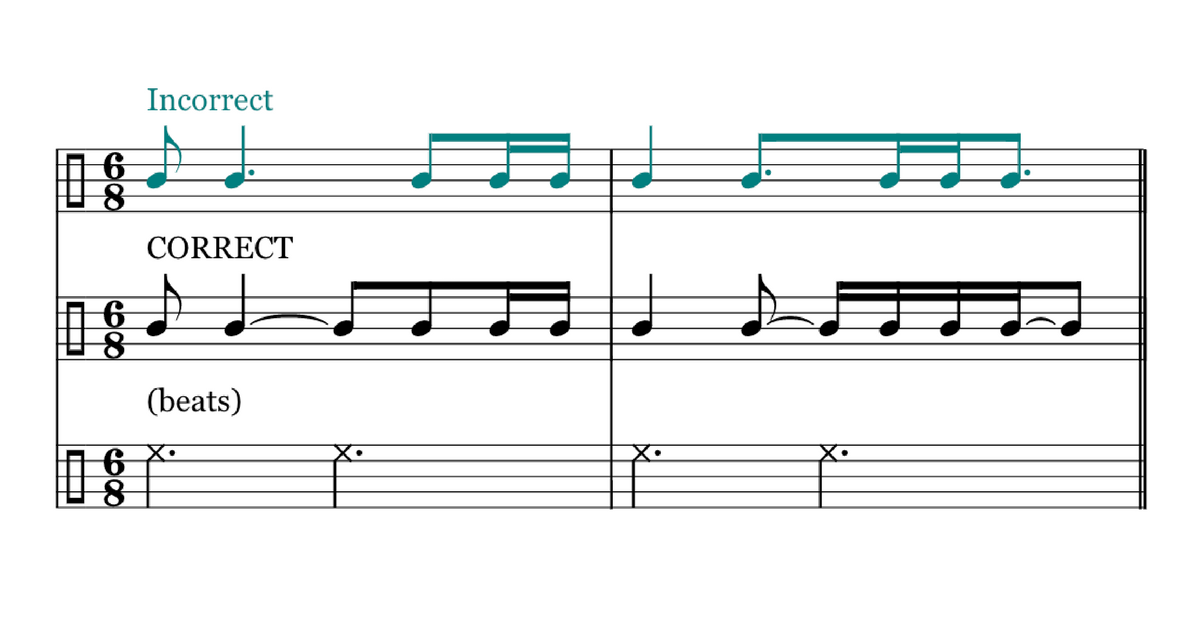One of the trickier problems that can come up in notating rhythm is when note values (rhythmic durations), ties, and beams, don’t match the way beats divide up in the given meter.
For example, look at this measure in 4/4 meter:
It’s correct in one way: the note values add up correctly to a full measure equivalent to four quarter notes. The problem is that the written note values imply a beat structure that doesn’t match the true beat structure of the bar.
In 4/4 time, the quarter note gets the beat. Quarters can be either divided or combined to create various note values and groupings. But all of those combinations occur over an underlying structure of even divisions by two, four, eight, sixteen, and so on:
Our goal is to notate our music so it visually lines up with that underlying structure, even if the sounding result — the actual note values and rhythms we hear — don’t divide evenly into two, four and so on. Look again at the first example, and notice how the note values don’t line up with the underlying 4×4 or 8×8 structure. For example, the first two notes combine to form a larger grouping of five eighth notes, not four!
Of course, there’s nothing wrong with hearing a grouping of five eighth note values. Again, we’re talking about a visual issue, not a sound issue: we don’t have to change the sound of the music one bit; all we have to do is change the notation so that the written note values match the underlying beat structure.
First, we change some note values so that we can actually see all four beats. Then, we add some ties to keep it sounding the same. The result looks like this:
Play the two alternative versions of the rhythm above, and you’ll hear that they sound identical; the only difference is in the way they’re written. Changing the half note to an eighth-plus-dotted-quarter value allows us to visually match up the underlying beats of one quarter note each with the actual sounding rhythm we want to perform. Adding the tie allows us to create a single, unbroken sound that lasts the same length of time as the half note, to avoid changing the way it sounds.
Why this Matters
At this point you may be asking: “why should I care, if this doesn’t change the sound, either in performance or in Noteflight playback?”
The reason is that notation is not only about sound: it’s also about sight. Beats are the structure, the scaffolding, of a measure. When a performer can’t see those beats, the structure is hidden, so it’s harder to hear and understand the structure, and it’s therefore harder to play the music — especially when the performer is sightreading or under the stress of a performance.
Just imagine: you’ve been hired to play the lead kazoo solo in a brand new piece in front of thousands of fans. You go onstage in five minutes, and the composer is way behind schedule so you have only just received the music…and the first two measures look like this:
(Before you play back the example in Noteflight, try tapping out the rhythm for yourself. Not easy!)
Now let’s show the beats below. Notice how only two of the notes in the melody line up with any of the beats — the two on the downbeats of each measure. All the other notes land between beats.
Our task is to change the note values so that there’s a written note on every beat. Then we’ll add ties to keep the sound the same:
It’s still a complicated rhythm, but you can now tap your foot to each beat and see exactly where each tap lines up with the notes you play. That’s going to help you a lot in that live performance!

